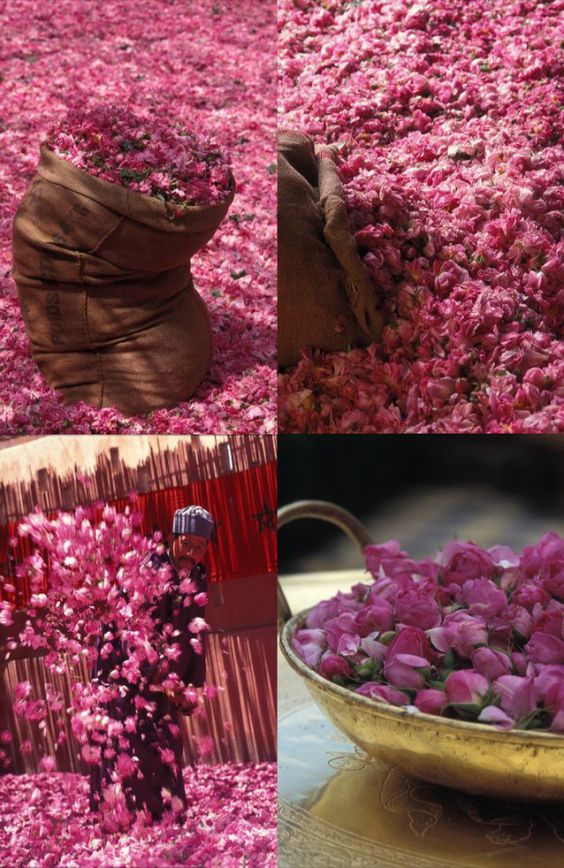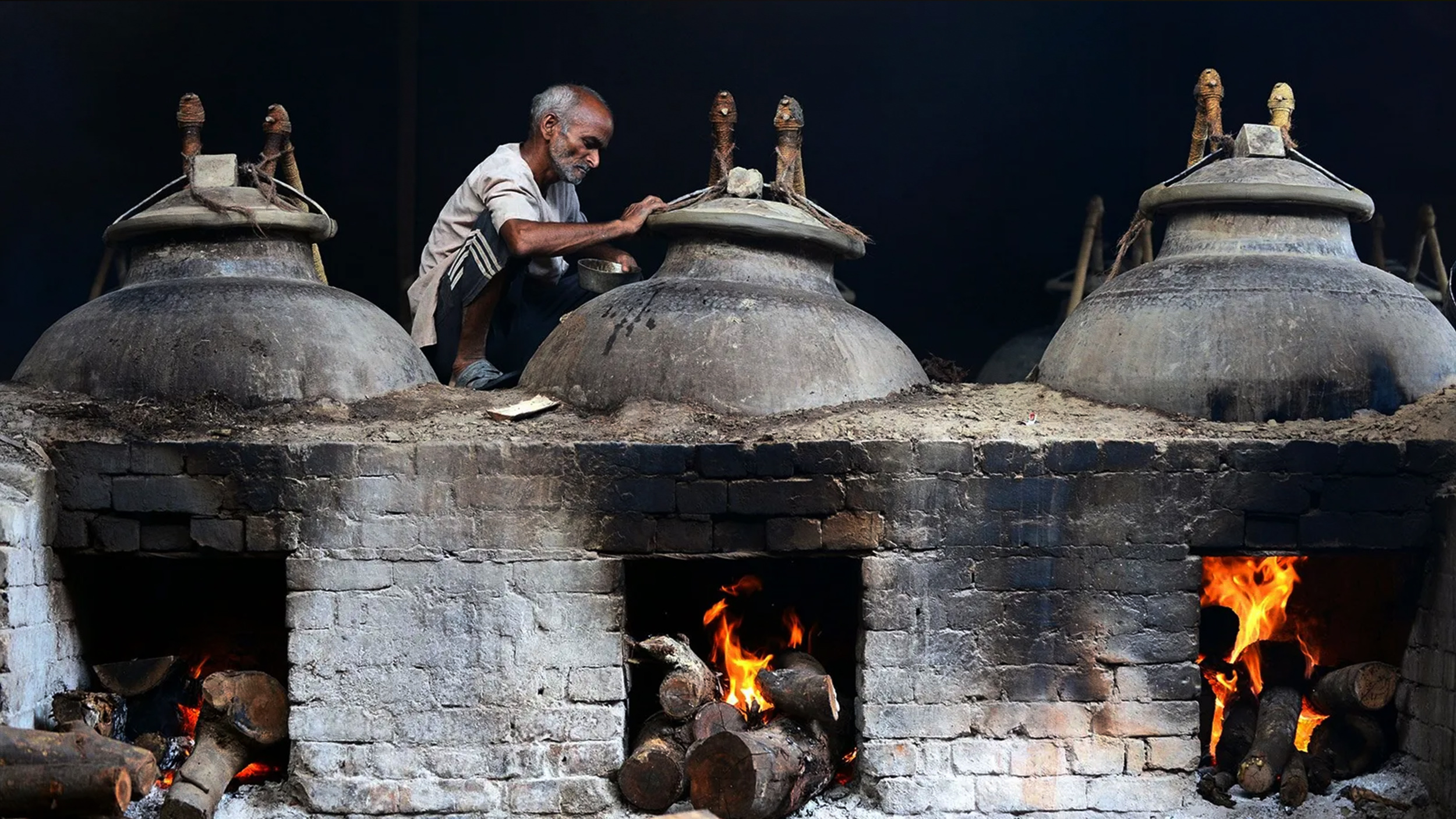For over four centuries, skilled artisans from Kannauj have been crafting rose attar through the most ancient method of perfume-making that is known globally.

The Damask rose is grown in various parts of India, but it thrives in the alluvial soils surrounding the city of Kannauj. For over four centuries, the highly fragrant roses from the area have been used to create rose attar through traditional distillation methods.
Every day, Tegh Singh heads to his flower farm on the banks of the Ganges before sunrise. He carefully picks the Rosa damascena flowers at their peak and places them in a jute sack slung over his shoulder. Singh then transports his harvest to Kannauj, known as India’s perfume capital.
Kannauj has been producing oil-based botanical perfumes called attar for centuries using the same time-honored distillation techniques. These fragrances were prized by both the Mughal royals and the ordinary people of ancient India, who were obsessed with scents. The attar was used to scent everything from food and fountains to homes and wrists.
Although attars lost popularity in the 20th century, Kannauj perfumers continue to create these sensuous scents using traditional methods. Today, a new generation of people both at home and abroad are rediscovering the allure of Kannauj attar.

Attar, a type of perfume originating from old-world practices, is created by crushing and infusing botanicals into oil or water. Unlike modern perfumes that use alcohol as a carrier, attars typically use sandalwood oil, resulting in a highly absorbent and long-lasting scent on the skin. In Kannauj, expert hands harvest Damask roses daily to be delivered to master attar makers who create enchanting scents with floral, woodsy, musky, smoky, or grassy notes that can be both warm and cooling. The region also produces unique attars such as mitti, which evokes the scent of earth after rainfall, and shamama, a blend of 40 or more flowers, herbs, and resins that takes days to make and months to age. Renowned perfume houses in Europe even use Kannauj attars as a layer in modern perfumery compositions. Perfume-making is truly an art form.

For more than 400 years, Kannauj has been famous for creating attar, known as ittr locally, using the traditional deg-bhapka method. This artisanal process involves using copper stills fueled by wood and cow dung, and it predates Grasse, which is now a major hub of perfume production in France. Kannauj is located just a few hours’ drive from historic Lucknow, and the town is a mixture of historical and modern elements. The market at Bara Bazaar is particularly noteworthy, where shops are filled with finely cut glass bottles of attar and ruh, and customers can try out different scents by dabbing perfumed cotton swabs behind their ears. Pranjal Kapoor, a fifth-generation partner at M.L. Ramnarain Perfumers, states that Kannauj attar is highly sought-after by the world’s best perfumers, and nothing else compares to it.

Upon arrival, Tegh Singh unloads his bundles of blossoms at Kapoor’s open-air stone courtyard, which serves as the distillery. Ram Singh, the master attar craftsman, places the petals in a copper still and adds fresh water. Before sealing it, he uses clay-and-cotton mash to create a sturdy seal around the rim. Once the mixture begins to simmer, steam is channeled from the still, via a bamboo reed, into a copper pot containing sandalwood oil that absorbs the rose-saturated vapor.
Ram Singh oversees the process for five to six hours, constantly checking the water temperature and listening for steam hissing sounds to determine when to add more wood to the fire. The process is repeated the next day, using a fresh batch of rose petals, to achieve the desired potency. The resulting rose attar is aged for several months in a camel-skin bottle to eliminate moisture. One kilo (2.2 pounds) of this liquid gold can fetch up to $3,000.
Kapoor emphasizes that his modest products rival those of top modern perfume houses in Grasse, despite the lack of gauges, meters, or electricity. He likens the difference to cooking daal in a rustic village kitchen versus an LPG stove or a microwave, noting that the taste would be entirely different. Ram Singh, now 50 years old, has been involved in the process since childhood and apprenticed with an attar guru for ten years.

Ancient Egyptians are credited with creating the earliest botanical perfumes by crushing plants and infusing them into oil. However, the first hydro-distillation process is attributed to Persian physician Ibn Sina in the 10th century. Archaeological findings in the Indus Valley suggest that perfume making developed even earlier. Islamic ruler Gyatri Shahi wrote the Book of Delights in the 15th century, which explored the world of sybaritic pleasures and emphasized the importance of smelling good. The Mughal empire, which invaded India in the 16th century, placed great value on fragrance for spiritual and sensual contentment. Emperor Akbar had a department solely dedicated to developing scents for personal and culinary use. Queens and courtesans were believed to wear their personal attars around their necks in miniature glass vials. Kannauj’s first royal patrons, Emperor Jahanghir and his queen Noor Jahan, sparked a run on rose attar after being captivated by the scent of Kannauj roses. Today, there is a resurgence of interest in fragrances and their historical significance.

“Why Kannauj?” you may ask. This town is located at the center point of three Mughal fortresses, namely Agra, Lucknow, and Kanpur, all of which are known for their appreciation of scents. Kannauj’s position on the fertile alluvial soil of the Ganges makes it an ideal location for growing jasmine, vetiver, and Damask rose, a flower that originated in central Asia but was named after Damascus. The town already had master perfumers before the Mughals arrived, so they only added to the demand for fragrances, which Kannauj was more than capable of supplying.
However, Kannauj has recently been struggling to keep up with the times. After the British took over India, demand for attar began to decline. Pure Mysore sandalwood was always expensive, but when the Indian government restricted its sale in the late 1990s, the price of attar skyrocketed. Concurrently, Indians who wished to present themselves as modern and successful shifted their allegiance to imported Western perfumes and deodorants. Nowadays, natural substitutes such as liquid paraffin are used instead of sandalwood, but these options do not quite match up to the original attar.

Nowadays, Kannauj attar is mainly exported to the Middle East and local Muslim communities in India. Gulab Singh Johrimal, located in Old Delhi’s Chandni Chowk, is a popular destination for Muslim men seeking attar for Friday prayers and Eid festivals. While Kannauj produces a large amount of rose water for paan, this is not enough to sustain the town’s distilleries, which have either closed or switched to producing replicas of Western perfumes. However, some are optimistic about the future of attar. Kapoor, for instance, spends much of his time promoting the traditional attar-making process and the terroir of Kannauj botanicals to top international perfume houses. He believes that Western tastes are shifting towards gilded scents like rose and shamama.
There is also a niche market for high-quality attar within India, particularly among younger generations. Anita Lal, the founder of Good Earth and Paro, two lifestyle brands rooted in traditional Indian design, sells classic rose and vetiver essential oils and hopes to reintroduce attar to younger consumers. However, attar faces several challenges, including the rarity of sandalwood and its outdated image compared to Western perfumes.
Jahnvi Lâkhòta Nandan, a native of Lucknow who trained as a master perfumer in Geneva and Paris, is perhaps the most prominent global ambassador for attar. She runs The Perfume Library in Goa and Paris, where she creates one or two new scents each year that bridge mythology and modernity. Attar is an important part of her repertoire, and her distillations are a blend of poetry, eccentricity, and science. In 2020, The Perfume Library launched Earthshine, a blend of nagarmotha, mimosa, and maulshree, which is deeply entwined with Kannauj and its attar-makers. According to Nandan, attar speaks to the soul and cannot be replicated in a lab in Europe.





